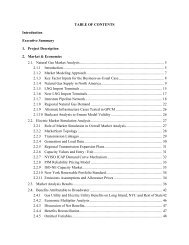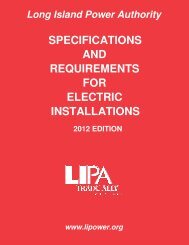Appendix E-2.c.i Energy Plan 2004-2013 Follow-up Studies and ...
Appendix E-2.c.i Energy Plan 2004-2013 Follow-up Studies and ...
Appendix E-2.c.i Energy Plan 2004-2013 Follow-up Studies and ...
Create successful ePaper yourself
Turn your PDF publications into a flip-book with our unique Google optimized e-Paper software.
1.1 Main Steam<br />
Re-powering Study for the Northport <strong>and</strong> Port Jefferson Power Stations<br />
<strong>Appendix</strong> II Northport System Descriptions<br />
1 System Descriptions for Hybrid Option<br />
Refer to PID-03-1A <strong>and</strong> 03-1B in <strong>Appendix</strong> III.<br />
1.1.1 Main Flow Path<br />
The Main Steam system conveys s<strong>up</strong>erheated steam from the HP s<strong>up</strong>erheater outlet of each HRSG to the<br />
steam turbine via the turbine main steam trip <strong>and</strong> control valves. The HRSGs s<strong>up</strong>ply main steam within<br />
the pressure <strong>and</strong> temperature limits required by the turbine design.<br />
Inside each HRSG boundary, the HP s<strong>up</strong>erheater contains an attemperator which uses HP feedwater to<br />
provide temperature control <strong>and</strong> maintain the HP s<strong>up</strong>erheater outlet temperature.<br />
Isolation of each HRSG from the main steam system header, in the Northport Hybrid Option HRSG<br />
configuration, is provided by a stop-check block valve located near the header. The turbine main steam<br />
trip <strong>and</strong> control valve provides positive isolation of the steam turbine from the main steam system.<br />
The Main Steam System also s<strong>up</strong>plies steam to the steam turbine gl<strong>and</strong> seals during start<strong>up</strong>. A pressure<br />
reducing valve <strong>and</strong> spray des<strong>up</strong>erheater is provided in the line to this service to lower the steam pressure<br />
<strong>and</strong> temperature to match the ST manufacturers’ requirements.<br />
Low point drain pots are located in the system in accordance with ASME TPD, “Recommended Practices<br />
for the Prevention of Water Damage to Steam Turbines Used for Electric Power Generation”.<br />
Depending on the location, low point drains are directed to either the condenser or the atmospheric<br />
blowoff tank associated with each HRSG.<br />
1.1.2 Bypass Flow Path<br />
The main steam bypass flow path provides the means to convey main steam from each HRSG to the cold<br />
reheat system via a main steam bypass conditioning valve station. During normal load operation, the<br />
main steam by-pass valves are shut. The bypass station permits main steam generated in each CT/HRSG<br />
set to be removed during normal CT start<strong>up</strong>, normal shutdown, steam turbine trip, or when the steam<br />
turbine is removed from service.<br />
The conditioning valve controls main steam pressure by bleeding off main steam, reducing its pressure<br />
<strong>and</strong> temperature to match the operating parameters of the cold reheat steam system. The conditioning<br />
valve controls the temperature of the outlet by spraying HP feedwater at a controlled rate to match the<br />
cold reheat steam temperature.<br />
1.2 Cold Reheat<br />
Refer to PID-03-02A in <strong>Appendix</strong> III.<br />
The Cold Reheat Steam System directs the high pressure steam turbine exhaust to each HRSG reheat inlet<br />
header. In the case of the Northport 4 Option, the cold reheat steam line from the steam turbine joins into<br />
a common header, which then splits into branches, one to each HRSG reheater inlet.<br />
For this option, a non-return valve is provided in the cold reheat line to prevent backflow into the high<br />
pressure turbine. This valve protects the turbine when the main steam system is bypassed to the cold<br />
March 30, 2009 146






